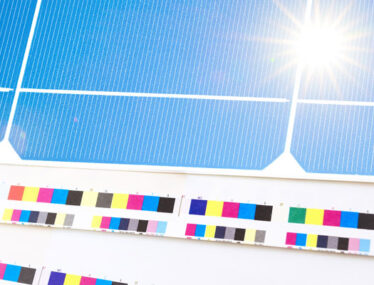The Inflation Reduction Act: A Catalyst for Change in the American Printing Industry?
By Angus Mathieson

Next-gen thin-film photovoltaics (PVs) have threatened to disrupt the solar industry for some time. Could the financial incentives of the Inflation Reduction Act be a game-changer for these technologies by creating a window of opportunity for new entrants from the established printing and coating industry? Asks TTP’s Angus Mathieson.
The US Inflation Reduction Act (IRA) has an ambitious yet clear goal: get American businesses making clean energy products over the next ten years and drive the US closer to energy independence.
Under the IRA, solar cells are earmarked for manufacturing tax credits right along the value chain from $12/m2 for silicon wafers to 4¢/W for a cell and 7¢/W for an assembled module. This is in addition to further R&D grants and incentives to deploy American-made solar technology.
Incentives are even available to aid investment in facilities for the production of PV module components that aren’t covered by the manufacturing tax credits, and new entrants can take heart from the fact that the manufacturing tax credits can be paid even if they don’t yet make a profit.
All of this is bound to create a frothy market for PV technologies. Established players will want to expand to get more products on the market, while new entrants and industrialists from other sectors will be looking for opportunities to take advantage of these incentives and get a foothold in this growth area. How quickly is the market likely to grow? According to the US Office of Energy Efficiency and Renewable Energy, at least 10-fold by 2035 [1] .
When most people think of solar PV, they think of silicon. Indeed, traditional solid-state silicon cells will continue to provide the backbone of the PV market. However, the IRA comes at a time when new “next gen” PV technologies are becoming technically viable and commercially attractive.
One factor that makes these new materials appealing is the fact that they can be processed in a liquid phase – that is, they can be coated onto a substrate using traditional printing techniques. This could make them less daunting to new starters when compared to the high CapEx requirement and complex, energy-intensive processes required for silicon PV manufacturing.
By being amenable to low-temperature, low-cost production processes, printable PVs may be quicker and cheaper to get from design to market, especially at moderate production volumes. This creates an opportunity to take full advantage of the tax incentives available within the timeframe of the IRA.
Next-gen photovoltaic materials
Next-gen PV covers a range of new approaches and materials. They include, for example, a plethora of thin film organic polymers that are of interest for indoor and low-power IoT applications.
Perhaps the most exciting class of materials however is the halide perovskites, a collection of hybrid organic/inorganic semiconductors with a host of impressive optoelectronic properties that make for a compelling active absorber layer in a solar cell.
At the time of writing, the record non-concentrated single-crystal silicon cell achieves a 26.1% power conversion efficiency (PCE), with perovskites hot on its tail at 25.7%. In a tandem configuration, whereby silicon and perovskites are layered together to capture as much of the optical spectrum as possible, a PCE of 32.5% has now been achieved – far surpassing the limits of any silicon-only cell.
As well as higher efficiencies, new PV approaches have other advantages, from lower cost of production – thanks to the fact that they are handled as liquids and at room temperatures – to enabling new applications. For example, cell chemistries can be tweaked for different applications, such as indoor vs. outdoor, stationary vs. mobile, and perhaps even specific geographic markets. The applications will be determined by the innovators that break cover in coming years. Moving beyond the standard ~2 m2 rigid silicon panels and moving towards flexible, lightweight solar cells in bespoke shapes and sizes, might engender opportunities to integrate solar energy into new areas and devices of our everyday lives.
A silicon PV manufacturing facility is a large, complex, and energy-intensive piece of infrastructure. Perovskites, on the other hand, can be printed directly onto flexible substrates using existing roll-to-roll production processes and facilities. This ability to use existing equipment reduces the timescales and CapEx required to get a perovskite PV fabrication facility off the ground and makes doing so an attractive option for someone looking to capitalise on the IRA’s window of opportunity, especially if they already have some of the relevant, translatable skills in-house.
Who can start a next-gen Solar PV facility, and how?
Companies with experience in industrial printing could have more of the skills to begin making next gen PV cells and modules than they may realise. This includes companies in roll-to-roll manufacturing, specialist coatings or printed plastics to name a few. It is possible that sections of a traditional production line could be tailored to begin printing energy-harvesting materials with little initial effort. Doing so could therefore present an opportunity to enter this rapidly developing market, with a reduced level of risk while the IRA’s financial incentives are in place.
Equally, a team with expertise in advanced materials – e.g., printed electronics or additive manufacturing – could design a proof-of-concept , find investment, and set up their own production facility much faster potentially than one could a new large-scale silicon foundry.
The proof-of-concept will need to incorporate a transparent conductive substrate, the active absorber layer, two charge transport layers, conductive contacts, and encapsulation. This need not be a massive R&D project. Many of the scientific challenges have already been solved at the cell level, and we know that no “show-stopping” scientific obstacles remain. The engineering problems, however, shouldn’t be underestimated.
The challenge now is to manufacture viable solar modules at a $/W basis over their lifetime that makes them commercially attractive. This is a big challenge, not only because the bar is set high by the existing silicon technology, but because this introduces complexities associated with encapsulation, balance of plant, and most importantly the manufacturing scale-up.
Exactly how long you should spend on cell design? This will be a trade-off. At one end, you could experiment with an almost infinite combination of charge transport layers, absorber layer compositions, dopants and film morphologies. At the other, you could buy proven compositions that can be loaded into a printing setup to make rough and ready, yet serviceable PVs. The key challenges permeating this field at present include the handling of toxic substances and the matter of reliably sealing the perovskite cell against the natural environment.
The market will likely welcome a mixture of approaches, and most will fall somewhere in between. Given the ten-year IRA deadline, there is an incentive to get moving and optimise as you go. But equally, the per wattage subsidy incentivises higher efficiencies and longer proven lifetimes.
Setting up roll-to-roll manufacturing
Once you have a design, you will need to set up scalable printing systems that can deposit the layers onto a substrate. The attraction of next gen PV is that this can be possible with standard printing equipment with only minor modification for optimisation. With regards to metallisation, breakthroughs in the printing of conductive contacts mean that the whole device could be made on a single production line, without the need to move the cell manually to a separate tool for the deposition of the metal contacts.
As the IRA pushes manufacturers to scale quickly, we may see bottlenecks in specialised PV equipment. If the right machinery is not available, companies will need to get creative, find alternative approaches to deliver their output, or repurpose machinery from other applications. This risk is certainly a critical factor in the anticipated roll out of silicon facilities in the US, due to the relatively concentrated market of equipment suppliers, with many of them based overseas. But with the right team, flexibility of manufacturing approaches is very much an inherent property of next gen PV solutions.
Moving from “good enough” to “world-beating”
So far so good. At one level, we might say that around 80% of the prerequisites for next gen PV are within reach: the machines, substrates, pre-cursors, even the designs if you borrow from published approaches. A good team could get a feasible solar cell into production reasonably quickly.
But the final 20% – making a reliable and cost-competitive product – is more challenging and likely to comprise 80% of the effort and time.
That 20% relates to oddities unique to the design, the process, and the properties of these new materials. It is this hard graft towards optimisation to squeeze out those extra percentage points of conversion efficiency and lifetime that will result in an attractive and scalable product.
In-line metrology and optimisation
This type of optimisation needs to be done in situ, not based on theory or one-off low-volume experiments. Perovskite solar cells are remarkably sensitive to their fabrication environment. It’s not uncommon for a cell made on a Monday to have 10% better efficiency than a cell made on a Tuesday, for reasons known only unto the cell itself! The more you understand about your design and your environment, the better your product, the quicker you can optimise, and the less waste (time and material) you create along the way.
A solution to this challenge that goes hand in hand with rapid scaling is intelligent data collection and analysis at the manufacturing line. Not only does this capability result in valuable product quality control, but by including inline metrology and characterisation you have a facility that can do research and optimisation as you go, perhaps even semi-autonomously.
Such a set up will allow you to explore thousands of subtle variations across the production process and environment and their effects on cell performance. The amount of data generated on a system printing many square meters of PV material per second, if collected continuously and coupled to carefully controlled monitoring infrastructure, could be the equivalent of years’ worth of discrete cm-scale lab research and optimisation, in just a few hours [2,3].
Doing this will require a metrology system bespoke to your process and an intelligent data processing infrastructure. Building this will need an expert team with overlapping skills in chemistry, physics, software, and electrical engineering, with an understanding of your specific facilities and materials. Not always an easy team to find and hire quickly. These final 20% of improvements are certainly challenging and need applied, multi-disciplinary expertise to tackle their idiosyncratic problems.
The process would begin with the down-selection of existing off-the-shelf technologies, followed by identifying and executing the necessary modifications. The finishing stages will include solving the inevitable challenges with scaling from one-off prototype runs to industrially relevant continuous production volumes.
At TTP we thrive on solving technology challenges of this type, helping companies to understand the technology routes available to them to create commercial opportunities. This is complemented by providing rapid access to bespoke teams of scientists and engineers to help overcome the hands-on challenges in scaling up next-gen solar panel production.
Contact Angus Mathieson to discuss how we can help.
References
[2] NG, L. W. T., Lee, S. W., Chang, D. W., Hodgkiss, J. M., Vak, D., Organic Photovoltaics’ New Renaissance: Advances Toward Roll-to-Roll Manufacturing of Non-Fullerene Acceptor Organic Photovoltaics. Adv. Mater. Technol. 2022, 7, 2101556. https://doi.org/10.1002/admt.202101556
[3] An, NG., Kim, JY., Vak, D., Machine learning-assisted development of organic photovoltaics via high-throughput in situ formulation. Energy and Environmental Science, 2021, 6, https://pubs.rsc.org/en/content/articlelanding/2021/EE/D1EE00641J



